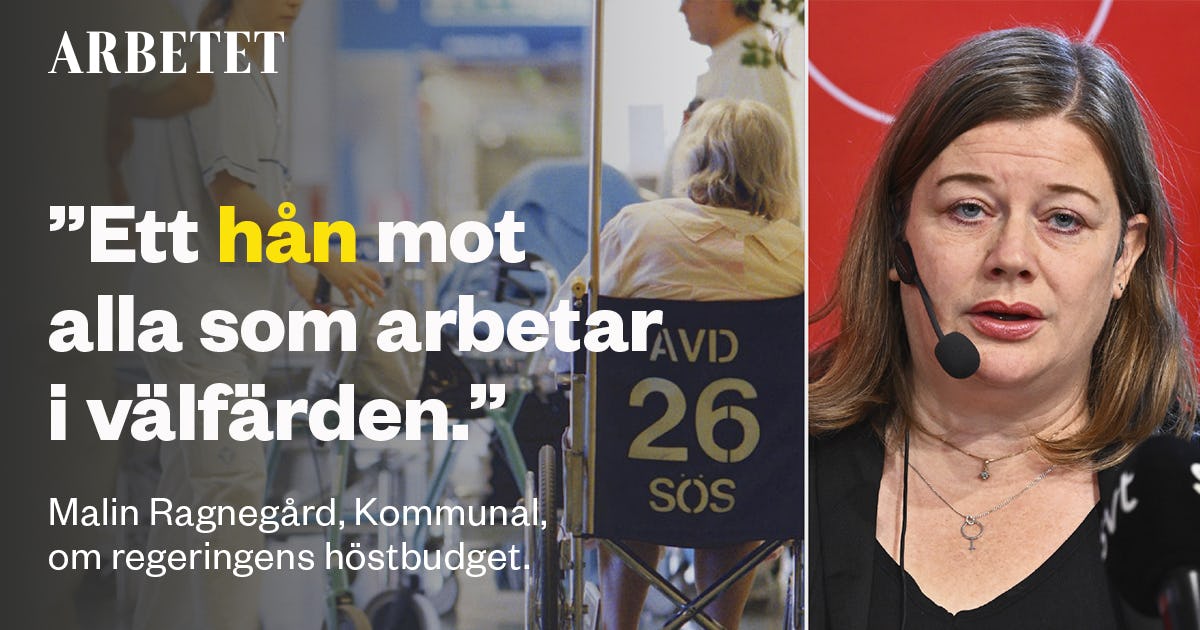The country’s municipalities will need an increased allocation in general government grants of $30 billion to deal with the difficult challenges they face, according to the municipal union’s calculations.
The Swedish employers’ organization SKR gets the corresponding figure to 20 billion.
When the government submitted the budget bill today It was clear that the increase would be only 6 billion.
An insult to everyone who works in luxury. For several years, there have been warnings about persistent underfunding and understaffing. This makes me really worried about the future of both the employees, but also all the citizens. Welfare becomes an accordion in municipal finances, says Malin Ranigaard, president of the Municipal Union.
SKR: That’s not enough
In the Swedish municipalities and regions, SKR, Madeleine Holm works in economic analysis.
It largely agrees with Kommunal’s description of the problem.
Just a few days ago, SKR submitted a letter to the government office explaining the difficult situation awaiting the country’s municipalities.
Well-being becomes an accordion in municipal finance
– It’s not common for us to do that. 6 billion of course welcome. But this is not enough in the long run. We estimate that increasing pension costs alone will cost municipalities roughly $23 billion, says Madeline Holm.
It will be noted for municipalities
On top of that, there are increasing costs for everything from food to energy, she continues. Therefore, Madeleine Holm expects many municipalities to end up in deficit next year.
This will appear, not least in municipalities that have already gone through financially difficult times.
– It has been a good situation for the municipalities in recent years, and many have managed to put money into the EQ reserves that now have to be withdrawn. But municipalities that have not been able to, there may be actual savings.
Better general government scholarships
In the budget, there are also some targeted grants for municipalities and regions, along with general grants.
Such examples amount to 1.6 billion to the school, which, among other things, will go to educational materials, additional law school and social teams, as well as two billion to districts for public welfare and health, including more places of care and maternity care.
Municipalities that have not been able to allocate reserves, there may be actual savings.
– On the SKR side, we’d rather see increased public contributions than targeted contributions. In difficult times like these, municipalities need the freedom to set difficult and effective priorities themselves, and then things like this run the risk of being somewhat ineffective. After all, we all know that it’s not the care places that municipalities and districts struggle with, but rather the employees who work in them, says Madeline Holm.
Facts/General Government Grants for Municipalities:
Since responsibility for large parts of public activities lies at the municipal level, there have been various forms of government subsidies to municipalities for at least 100 years. Today, it is estimated that about 40 percent of all municipal spending goes to schools and childcare, while welfare and welfare burden municipalities with about 20 percent of finances.
General government subsidies have been the dominant type of government subsidy in Sweden since the subsidy reform in 1993. This means that the municipalities themselves can decide how the money is to be used, and government subsidies come in the form of a ‘sack of money’ and are not conditional.
Public contributions to municipalities in 2019 amounted to nearly 120 billion, and in 2020 to nearly 158 billion (the increase is mainly due to the epidemic) and fell in 2021 by about 153 billion.
General government grants account for about 15 to 16 percent of the municipalities’ total income, the rest coming mainly from taxes from residents.
Source: Ekonomifakta, SKR, Statistics Sweden, Statskontoret

“Falls down a lot. Internet fanatic. Proud analyst. Creator. Wannabe music lover. Introvert. Tv aficionado.”




More Stories
More than 100 Republicans rule: Trump is unfit | World
Botkyrka Municipality suspends its directors after high-profile trip to New York
Huge asteroid approaching Earth | World